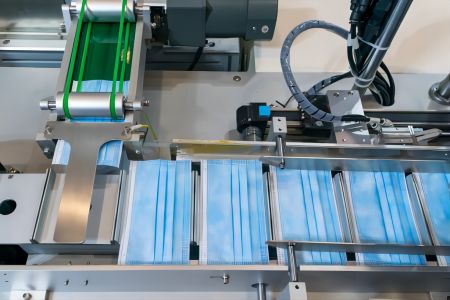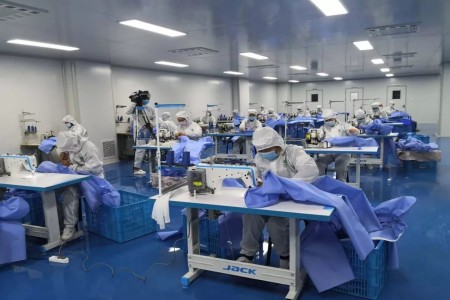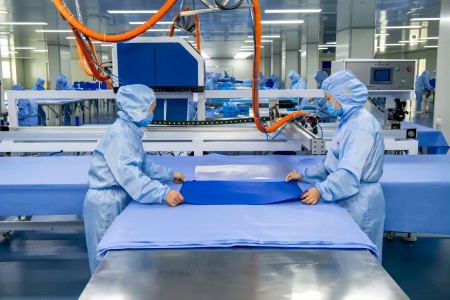2023/6/16

How Non Woven Fabric is Revolutionizing the Face Mask Industry
The COVID-19 pandemic has brought the face mask industry into the spotlight, with a surge in demand for protective masks. As a result, manufacturers are constantly looking for ways to improve the quality and effectiveness of face masks. One such innovation that is rapidly gaining popularity is the use of non-woven fabric.
Non-woven fabric is a synthetic material that is made from long fibers that are bonded together through heat, pressure or chemicals. It is lightweight, durable, and has excellent filtration properties, making it an ideal material for face mask production. Non-woven fabric is revolutionizing the face mask industry by providing a comfortable and breathable option that is highly effective in protecting against airborne particles. In this article, we'll delve deeper into the advantages of non-woven fabric and how it's changing the face mask industry for the better.
The Evolution of Face Masks
Face masks have been used for centuries to protect against airborne particles and diseases. However, the design and materials used in face masks have evolved over time. In the past, face masks were made from natural materials such as cotton or silk. These materials were not as effective in filtering out airborne particles, and they were not as durable as the materials used in modern face masks.
With the advancement of technology, face masks have become more sophisticated and effective. The use of non-woven fabric has been a game-changer in the face mask industry. Non-woven fabric is made from synthetic materials, which makes it more durable and effective in filtering out airborne particles. The use of non-woven fabric has also allowed for the production of disposable face masks, which are more hygienic and convenient than reusable masks.
Advantages of Non-woven Fabric in Face Masks
Non-woven fabric has several advantages over traditional materials used in face masks. Firstly, non-woven fabric is highly effective in filtering out airborne particles. It has a tight weave that prevents particles from passing through, which makes it an ideal material for face masks.
Secondly, non-woven fabric is lightweight and breathable, which makes it more comfortable to wear for extended periods. It does not trap heat or moisture, which can cause discomfort and skin irritation. This makes non-woven fabric face masks a popular choice for healthcare workers who need to wear masks for long periods.
Thirdly, non-woven fabric is durable and does not easily tear or fray. This makes it a cost-effective material for face mask production. Non-woven fabric face masks can be produced at a lower cost than masks made from traditional materials, which makes them more accessible to the general public.
How Non-woven Fabric is Made
Non-woven fabric is made by bonding long fibers together through heat, pressure, or chemicals. The process of making non-woven fabric involves several steps, including fiber preparation, web formation, and bonding.
In the fiber preparation stage, the raw materials are prepared by mixing and blending them to achieve the desired properties. The fibers are then formed into a web through a process called web formation. This involves laying the fibers down on a conveyor belt in a random pattern.
In the bonding stage, the fibers are bonded together using heat, pressure, or chemicals. Heat bonding involves applying heat to the fibers, which melts them and fuses them together. Pressure bonding involves applying pressure to the fibers, which compresses them and fuses them together. Chemical bonding involves applying chemicals to the fibers, which react and bond them together.
Types of Non-woven Fabrics Used in Face Masks
There are several types of non-woven fabrics used in face masks, each with its own unique properties. Some of the most common types of non-woven fabrics used in face masks include spunbond, meltblown, and spunlace.
Spunbond non-woven fabric is made by bonding long fibers together through heat and pressure. It is lightweight, durable, and has excellent filtration properties. Spunbond non-woven fabric is commonly used in the production of disposable face masks.
Meltblown non-woven fabric is made by melting and blowing synthetic fibers together to form a web. It is highly effective in filtering out airborne particles and is commonly used in the inner layer of face masks.
Spunlace non-woven fabric is made by bonding fibers together through a process called hydroentanglement. It is soft, comfortable, and has excellent water absorption properties. Spunlace non-woven fabric is commonly used in the production of medical and surgical face masks.
Non-woven Face Mask Production Process
The production process for non-woven face masks involves several steps, including material preparation, mask forming, and earloop welding. In the material preparation stage, the non-woven fabric is cut into the desired shape and size.
In the mask forming stage, the non-woven fabric is folded and pressed to form the mask. The mask is then fitted with earloops, which are welded onto the mask through a process called ultrasonic welding.
Once the masks are formed and fitted with earloops, they are packaged and sterilized. Non-woven face masks are typically sold in packs of 50 or 100 and are designed for single-use.
The Impact of Non-woven Face Masks on the Environment
Non-woven face masks are typically designed for single-use and are disposed of after each use. This has led to concerns about the environmental impact of non-woven face masks.
Non-woven face masks are made from synthetic materials, which do not biodegrade easily. This means that they can remain in the environment for a long time and contribute to pollution. However, some manufacturers are now producing biodegradable face masks, which are designed to break down more easily in the environment.
Future of Non-woven Face Masks
The non-woven face mask industry is expected to continue growing in the coming years, driven by increasing demand for protective masks. Manufacturers are constantly looking for ways to improve the quality and effectiveness of face masks, and the use of non-woven fabric is likely to play a key role in this.
In addition, the COVID-19 pandemic has highlighted the importance of having a reliable supply chain for face masks. Governments and healthcare organizations are now investing in domestic production facilities to ensure a steady supply of face masks in the event of future pandemics.
Conclusion
Non-woven fabric is revolutionizing the face mask industry by providing a comfortable and breathable option that is highly effective in protecting against airborne particles. The use of non-woven fabric has several advantages over traditional materials used in face masks, including excellent filtration properties, lightweight and breathable design, and low cost of production.
The non-woven face mask industry is expected to continue growing in the coming years, driven by increasing demand for protective masks. However, there are concerns about the environmental impact of non-woven face masks, and manufacturers are now producing biodegradable face masks to address these concerns. Overall, non-woven fabric is a game-changer in the face mask industry and is likely to play a key role in future developments in this field.



 WhatsApp
WhatsApp
Send us your message
You can send an email asking for the price and detailed information of this product. We will reply you as soon as we receive your email